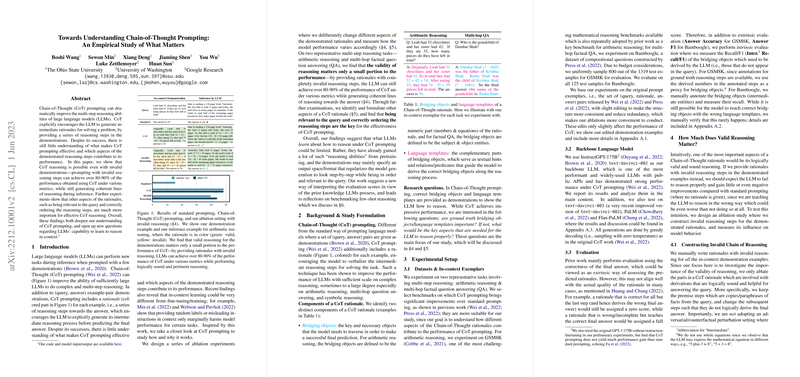A Detailed Examination of Chain-of-Thought Prompting: Analytical Insights and Implications
The paper "Towards Understanding Chain-of-Thought Prompting: An Empirical Study of What Matters" explores the significant yet underexplored topic of Chain-of-Thought (CoT) prompting in LLMs. The research presents a comprehensive empirical analysis to identify the key determinants of CoT prompting efficacy.
Introduction and Methodology
The research focuses on disentangling the mechanisms that make CoT prompting effective for multi-step reasoning tasks in LLMs. Despite prior successes in using CoT for improving the reasoning ability of models, there is limited understanding of which aspects of CoT demonstrations are crucial for this enhanced performance. To address this gap, the authors designed ablation experiments to systematically alter various components of CoT rationales, examining their effect on model performance.
Key Findings
Validity of Reasoning Steps
One of the bold claims put forth by the paper is that the validity of reasoning steps in CoT examples plays a less significant role in determining model performance than previously assumed. Even with completely invalid reasoning steps, models achieved 80-90% of the performance metrics compared to those provided with valid CoT. This is illustrated through rigorously designed ablation experiments on two prominent multi-step reasoning tasks: arithmetic reasoning (GSM8K) and multi-hop factual question answering (Bamboogle).
Relevance and Coherence
The paper identifies two critical components for CoT rationales:
- Relevance: Refers to the components being based on, and related to, the query.
- Coherence: Concerns the logical ordering of steps.
Through their experiments, the authors found that both relevance and coherence are pivotal for maintaining the efficacy of CoT prompting. Specifically:
- Relevance Matters More for Bridging Objects: While coherence is important, relevance appears to impact performance more significantly. Demonstrations where the bridging objects were relevant but incoherent performed better than those with irrelevant but coherent objects.
- Coherence of Language Templates is Crucial: Conversely, the logical flow and order within language templates themselves are essential, as incoherent language templates significantly degraded performance.
Numerical Results
The quantitative results showcase several critical metrics:
- Arithmetic Reasoning (GSM8K): The intrinsic performance, measured by Intermediate Recall and F1 score, dropped from 48.3 to 43.9 when reasoning steps were invalid. Substantial decreases were observed in settings where relevance or coherence was ablated, particularly when both were destroyed.
- Factual QA (Bamboogle): The performance drop was also marked, with Answer F1 dropping from 45.2 to 39.4 in invalid reasoning settings, and even lower in the no-coherence and no-relevance settings.
Implications for AI Developments
Practical Implications
This paper suggests that for practical implementations of CoT prompting in real-world applications, ensuring the relevance and coherence of reasoning steps should be prioritized over merely validating their logical correctness. This shifts the focus towards designing demonstrations that effectively guide the model in maintaining a structured and pertinent reasoning pathway.
Theoretical Speculations
The findings invite reflection on how LLMs leverage their pre-trained knowledge for reasoning tasks. The models' ability to perform well even with invalid reasoning steps indicates that they are not necessarily learning new reasoning procedures from CoT prompting, but rather aligning their output with pre-existing competencies. This underlines the importance of understanding the extent of pre-trained models' intrinsic reasoning capabilities and designing better benchmarks to evaluate true learning.
Future Directions
The research opens several avenues for further exploration:
- Broader Evaluation Benchmarks: To better gauge the extent of reasoning capabilities acquired through pre-training and to evaluate the efficacy of CoT prompting, it would be essential to explore a wider range of benchmarks where LLMs might possess varying levels of pre-training familiarity.
- Advanced Analysis Techniques: Developing more systematic and automated methods to generate and evaluate invalid reasoning may provide deeper insights and help in fine-tuning CoT prompts for different model architectures and tasks.
- Instruction Fine-Tuning: Investigating the impacts of instruction fine-tuning, as evidenced by the observed performance in models like text-davinci-002 and text-davinci-003, to understand how such training paradigms influence reasoning abilities.
Conclusion
The paper delivers a detailed and nuanced understanding of what makes CoT prompting effective, challenging previously held assumptions about the necessity of valid reasoning demonstrations. The insights gained underscore the importance of relevance and coherence in demonstrations, significantly contributing to our broader understanding of LLMs' capabilities and limitations in reasoning tasks. This work sets the stage for future research to explore more refined techniques and benchmarks for fully leveraging the potential of LLMs in complex reasoning tasks.
